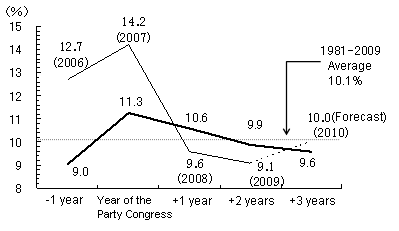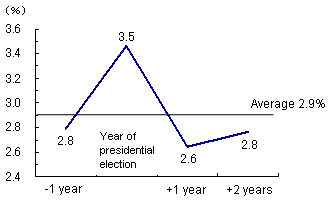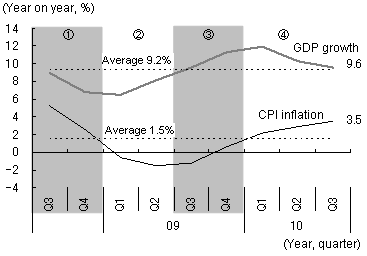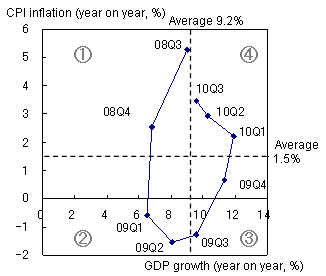China has adopted a tightening policy as an anti-inflationary measure, and economic growth is slowing as a consequence. In the next year, however, the downward trend in inflation will become evident, and the authorities will gradually have greater leeway to loosen monetary policy. In 2012, the Chinese economy is expected to recover strongly, coinciding with the Communist Party Congress (Party Congress) to be held for the first time in five years.
From overheating to an adjustment phase
Although Chinese economic growth slowed as exports plunged in the wake of the collapse of Lehman Brothers in September 2008, GDP growth (in real terms in this paper) reached 9.1% in 2009, exceeding the initial target of 8%, thanks to expansionary fiscal and monetary policies that were promptly implemented by the government. In 2010, GDP enjoyed double-digit growth of 11.1% year on year in the first half, aided by a recovery in exports. However, inflation has been accelerating with the recovery, and the consumer price index (CPI) rose 3.6% year on year in September 2010, marking its highest point since October 2008.
In response to the rising inflation, the authorities have shifted the focus of their macroeconomic policies from growth to stabilization. First, ceilings on bank loans, which were eased substantially after the Lehman shock, were tightened once again in the spring of 2009. The reserve requirement ratio for banks has been raised four times since the beginning of 2010. In October, the authorities finally raised interest rates (Note).
These policies have been effective in cooling the economy. First, GDP growth has been slowing gradually, from 11.9% year on year at its peak in the first quarter of 2010 to 10.3% in the second quarter and 9.6% in the third quarter. Given the strong observed correlation, in which the rise in CPI lags GDP growth by approximately three quarters, it is expected that the climbing inflation rate is about to reach a turning point, reflecting the slowing pace of economic growth. In fact, the year-on-year rate of increase in the producer price index (PPI), a leading indicator of the CPI, peaked in May 2010 and has since fallen.
A full recovery toward the Party Congress
When forecasting the future direction of the Chinese economy, the historical pattern of business cycles serves as a useful guide.
First, the business cycle in China can be divided into the following four stages, based on whether GDP growth and the inflation rate are above or below their average values for the period concerned: (1) low growth and high inflation, (2) low growth and low inflation, (3) high growth and low inflation, and (4) high growth and high inflation (Figure 1). Looking at the period following the Lehman Brothers failure in September 2008, the Chinese economy has proceeded through the stage of low growth and high inflation (the last two quarters of 2008), the stage of low growth and low inflation (the first two quarters of 2009) and the stage of high growth and low inflation (the last two quarters of 2009). It has now entered the stage of high growth and high inflation (from the first quarter of 2010 to the third quarter). The Chinese economy is expected to move into a state of low growth and high inflation from now, and then to low growth and low inflation next year, in the form of cooling inflation. Consequently, China will shift from monetary tightening to easing.
| Figure 1: Business Cycle in China after the Lehman Brothers Collapse | |
a) Changes in GDP growth and inflation b) GDP growth and inflation relative to their respective average values | |
| (Note) | (1) stage of low growth and high inflation; (2) stage of low growth and low inflation; (3) stage of high growth and low inflation; and (4) stage of high growth and low inflation |
| (Source) | CEIC Database |
Meanwhile, the Chinese economy has followed a five-year cycle in which the growth rate peaks in the year the Party Congress is held (Figure 2). While average GDP growth in China from 1981 to 2009 has been 10.1%, it has been higher, at 11.3%, in years when the Party Congress is held. Indeed, GDP growth reached 14.2% in 2007 when the Party Congress was last held. The 18th Party Congress is to be held in the fall of 2012, and the Chinese economy is likely to turn upward as a result, after going through an adjustment phase in 2011.
| Figure 2: Business Cycle in China in tandem with the Communist Party Congress | |
 | |
| (Note) | The thick line shows the average growth rates for the years specified in the period between 1981 and 2009. For example, the growth rate for the 'Year of the Party Congress' shows the average for 1982, 1987, 1992, 1997, 2002, and 2007. The thin line shows the growth rate in each year after 2006, and that for 2010 reflects the author's forecast. The Party Congress is held every five years, and the previous (17th) Party Congress was held in October 2007. |
| (Source) | National Bureau of Statistics of China |
Will the global economic boom come in 2012?
As in the case of China, the U.S. economy also tends to follow a political business cycle, with GDP growing faster during years in which a presidential election is held (once every four years). In fact, while average GDP growth from 1976 to 2009 is 2.9% in the United States, the average growth rate for election years is highest at 3.5% (Figure 3).
| Figure 3: Business Cycle in the U.S. in Tandem with the Presidential Election | |
 | |
| (Note) | Average real GDP growth from 1976 to 2009 |
| (Source) | US Bureau of Economic Analysis |
For the first time in 20 years, these political business cycles in the United States and China will peak simultaneously in 2012. While China was still a small economy in 1992 when the two events last coincided, the situation will be very different in 2012. If the United States and China, the world's largest and second largest economies, enjoy robust growth at the same time, other countries will no doubt reap significant benefits.




